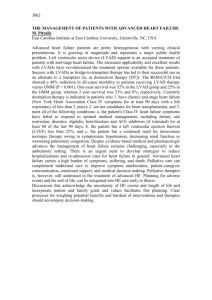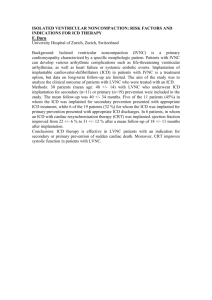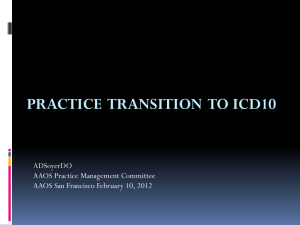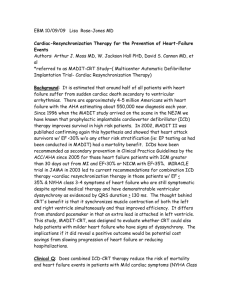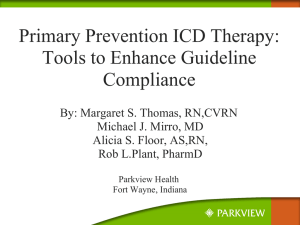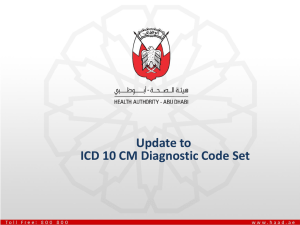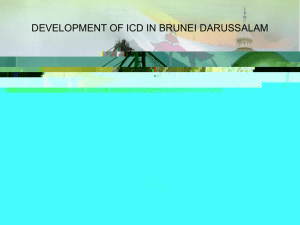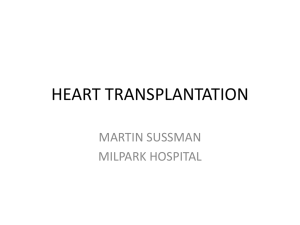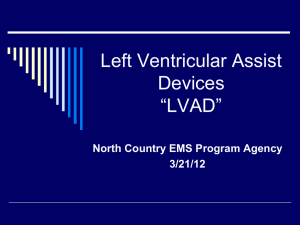Major Medical Decisions in Advanced Heart Failure
advertisement
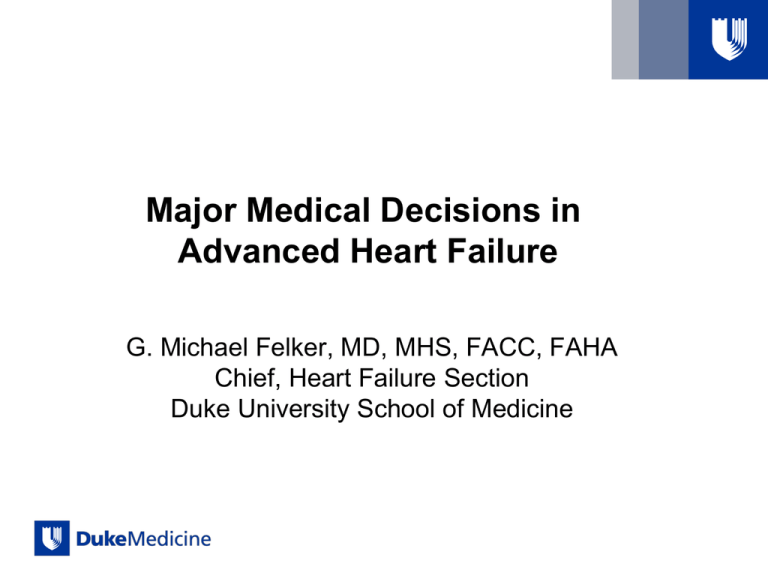
Major Medical Decisions in Advanced Heart Failure G. Michael Felker, MD, MHS, FACC, FAHA Chief, Heart Failure Section Duke University School of Medicine Disclosures • Grant Support and/or Consulting – – – – – – – – – NIH/NHLBI Novartis Amgen Trevena Roche Diagnostics Otsuka Celladon St Judes Singulex Allen, LA et al. Circulation, 2012 Variable Clinical Course of Heart Failure Allen L A et al. Circulation 2012 Defining Options Medical decision making is not a menu where the patient choses from among all available treatment options Clinicians are responsible for defining the range of medically appropriate options. Presentation of options should include: alternative approaches range of anticipated outcomes, including QoL “what if?” scenarios Typical Medical Decisions in Advanced Heart Failure • Should we place an ICD? • Should we list for heart transplant? • Should we place a ventricular assist device as destination therapy? • Should we involve palliative care? ICDs in Chronic HF 30.0% Control Therapy 28.8% P=0.007 % Mortality 25.0% 20.0% 22.0% 19.8% P=0.016 19.0% P=0.004 14.2% 15.0% 12.0% 14.1% P=0.065 7.9% 10.0% 5.0% 0.0% MADIT II COMPANION HF Etiology Ischemic: 100% Ischemic:59% Non-ischemic:41% NYHA Class I/II/III (35%/35%/30%) III/IV (87%/13%) I/II/III (20%/60%/20%) II/III (71%/29%) < 30% < 35% < 35% < 35% 1232 1520 458 2521 2 months 12 months 24 months 45 months 17 14 17 14 0.69 0.64 0.66 0.77 LVEF No. Pts Follow-Up NNT Hazard Ratio DEFINITE Non-ischemic: 100% SCD-HeFT Ischemic: 52% Non-ischemic:48% Device Therapy for Stage C HFrEF I IIa IIb III ICD therapy is recommended for primary prevention of SCD to reduce total mortality in selected patients with nonischemic DCM or ischemic heart disease at least 40 days post-MI with LVEF of 35% or less, and NYHA class II or III symptoms on chronic GDMT, who have reasonable expectation of meaningful survival for more than 1 year. I IIa IIb III ICD therapy is recommended for primary prevention of SCD to reduce total mortality in selected patients at least 40 days postMI with LVEF less than or equal to 30%, and NYHA class I symptoms while receiving GDMT, who have reasonable expectation of meaningful survival for more than 1 year. Device Therapy for Stage C HFrEF I IIa IIb III The usefulness of implantation of an ICD is of uncertain benefit to prolong meaningful survival in patients with a high risk of nonsudden death as predicted by frequent hospitalizations, advanced frailty, or comorbidities such as systemic malignancy or severe renal dysfunction. *Counseling should be specific to each individual patient and should include documentation about the potential for sudden death and non-sudden death from HF or non-cardiac conditions. Information should be provided about the efficacy, safety, and potential complications of an ICD and the potential for defibrillation to be inactivated if desired in the future, notably when a patient is approaching the end of life. Primary Prevention ICD in context • Out of 100 patients with an ICD implanted for primary prevention and followed for 4 years: – 70 will never receive a shock – Of the 30 who do receive a shock, 13 of those shocks will be inappropriate – 17 will have an appropriate shock that prevents SCD – 10 of those pts will go onto die of something else – 7 lives will be saved by implanting an ICD • 14 ICD’s will be implanted to save 1 life (NNT = 14) Extrapolated from SCD-HeFT results ICD Take Home Message • ICD clearly improve survival in well defined groups of patients with heart failure • Data on ICD therapy in patients with more advanced HF is very limited • Important limitations of ICD therapy – ICDs do not improve symptoms or QOL – ICDs may decrease QOL (frequent shocks) – ICDs are designed to identify and treat a specific type of mortal event (ventricular tachy-arrhythmias) Typical Medical Decisions in Advanced Heart Failure • Should we place an ICD? • Should we list for heart transplant? • Should we place a ventricular assist device as destination therapy? • Should we involve palliative care? ADULT HEART TRANSPLANTS Kaplan-Meier Survival by Era (Transplants: January 1982 - June 2010) 100 1982-1992 vs. 1993-2002: p < 0.0001 1982-1992 vs. 2003-6/2010: p <0.0001 1993-2002 vs. 2003-6/2010: p <0.0001 Survival (%) 80 60 1982-1992 (N = 25,138) 1993-2002 (N = 37,193) 40 2003-6/2010 (N = 24,021) 20 HALF-LIFE 1982-1992: 8.5 years; 1993-2002: 10.9 years; 2003-6/2010: NA 0 0 1 2 3 4 5 6 7 8 9 Years ISHLT 2012 J Heart Lung Transplant. 2012 Oct; 31(10): 1045-1095 10 11 12 13 14 15 POST-HEART TRANSPLANT MORBIDITY FOR ADULTS Cumulative Morbidity Rates in Survivors within 1, 5 and 10 Years PostTransplant (Follow-ups: January 1995 – June 2011) Within 1 Year Total N with known response Within 5 Years Total N with known response Hypertension* 72.8% (N = 25,542) 92.6% (N = 11,853) – Renal Dysfunction 26.7% (N = 27,478) 53.0% (N = 13,481) 68.2% Outcome Total N Within with known 10 Years response 18.3% 33.2% 37.5% Creatinine > 2.5 mg/dl 6.6% 15.8% 21.1% Chronic Dialysis 1.5% 2.9% 6.1% Renal Transplant 0.3% 1.2% 3.6% Abnormal Creatinine < 2.5 mg/dl Hyperlipidemia* 60.2% (N = 26,810) 88.0% (N = 13,191) – Diabetes* 26.5% (N = 27,474) 38.0% (N = 13,306) – Cardiac Allograft Vasculopathy 7.9% (N = 24,790) 30.4% (N = 9,819) 49.7% ISHLT 2012 J Heart Lung Transplant. 2012 Oct; 31(10): 1045-1095 (N = 4,339) (N = 2,482) * Data are not available 10 years post transplant Cardiac Transplantation I IIa IIb III Evaluation for cardiac transplantation is indicated for carefully selected patients with stage D HF despite GDMT, device, and surgical management. Cardiac Transplantation Evaluation • • • • • • • • • • • • • • • • • • • Complete history and physical examination CBC, BMP, LFT, coags, UA Serologic testing for syphilis, HIV, hepatitis B & C, CMV,EBV, VZV, toxo Tb skin testing ABO, HLA typing, panel reactive antibody screening 12 lead ECG Echocardiogram Chest xray Cardiopulmonary exercise testing Right heart catheterization with vasodilator challenge if appropriate Age appropriate cancer screening PFTS Carotid ultrasound VQ scan Dental evaluation Psychosocial evaluation Social work evaluation Nutrition consult Financial Evaluation Transplant is Epidemiologically Trivial 300 million 2.6% w/ HF (7 milllion) 50% sys HF 25% NYHA III 5% NYHA IV (150200K) 10% NYHA IIIB (300350K) IIIB+IV (250-300K) [<75 yrs] ~2300 transplant/year Miller LW. Circulation 2011 Typical Medical Decisions in Advanced Heart Failure • Should we place an ICD? • Should we list for heart transplant? • Should we place a ventricular assist device as destination therapy? • Should we involve palliative care? Improving Survival with Continuous Flow LVAD 100 90 HM II BTT Starling JACC 2011 Percent Survival 80 HM II BTT Pagani JACC 2009 70 HM II BTT Miller NEJM 2007 60 HM II DT Slaughter NEJM 2009 50 40 VE DT LVAD REMATCH Rose NEJM 2001 30 XVE DT LVAD Slaughter NEJM 2009 20 Novacor DT LVAD INTrEPID Rogers JACC 2007 10 OMM REMATCH Rose NEJM 2001 OMM INTrEPID Rogers JACC 2007 0 0 6 12 Months 18 24 Improvement in Functional Capacity with Mechanical Support Rogers, JG et al. JACC 2010 Changing Landscape of Mechanical Support Stewart and Stevenson. Circulation 2011;123:1559-68. Landscape of potential VAD patients AHA/ACC classification NYHA classifications Stage C Class III INTERMACS Profiles Stage D Class IIIb/IV 7 6 Class IV 5 Range of HM II DT Approval and CMS Coverage 4 3 2 Approved General Range of Market Adoption Not Broadly Adopted Generally Accepted Ambulatory Class IIIB and IV INTERMACS 6: Walking Wounded INTERMACS 5: Exertion intolerant INTERMACS 4: Resting symptoms on oral therapy at home Less Sick ROADMAP Sick 1 Limitations of of LVAD Therapy • • • • • • • Right heart failure Pump thrombosis Stroke Recurrent GI bleeding Arrhythmias Aortic insufficiency Drive line infections Mechanical Circulatory Support I IIa IIb III MCS use is beneficial in carefully selected* patients with stage D HFrEF in whom definitive management (e.g., cardiac transplantation) or cardiac recovery is anticipated or planned. I IIa IIb III Nondurable MCS, including the use of percutaneous and extracorporeal ventricular assist devices (VADs), is reasonable as a “bridge to recovery” or a “bridge to decision” for carefully selected* patients with HFrEF with acute, profound hemodynamic compromise. I IIa IIb III Durable MCS is reasonable to prolong survival for carefully selected* patients with stage D HFrEF. Re-hospitalizations after LVAD Total Readmissions Hospital Days Smedira, N. et al. JACC-Heart Failure, 2013 The Importance of Frailty Patient Selection for Advanced Heart Failure Therapy Flint, KM. Circ Heart Fail 2012;5:286-93 “…it is challenging to locate the intersection of patients who face high mortality without LVAD and yet can look forward to good outcomes with LVAD.” Stewart and Stevenson. Circulation 2011. LVAD Take Home • Destination LVAD therapy can provide substantial improvement in survival and functional capacity in selected patients with advanced heart failure • It is also associated with a multiple major morbidities and a high risk of unplanned rehospitalization • Patient selection with attention to those comorbidities likely to be improved by VAD therapy vs. those not is key Other Important Considerations • Even non-cardiac procedures may lead to progressive heart failure and cardiogenic shock • Many ‘temporary’ forms of support may be associated with failure to wean and ‘dependence’ – – – – Cardiopulmonary bypass Inotropic therapy IABP Mechanical Ventilation • Need for discussion of “what if” outcomes where feasible in advance Typical Medical Decisions in Advanced Heart Failure • Should we place an ICD? • Should we list for heart transplant? • Should we place a ventricular assist device as destination therapy? • Should we involve palliative care? Palliative Care is: • Specialized medical care for people with serious illness • Relief from symptoms, pain and stress – whatever the diagnosis • Improve quality of life for both patient and family • A team that provides an extra layer of support • Appropriate at any age and at any stage of illness – Can be provided together with curative treatment Diagnosis of Serious Illness Palliative Care Models End of Life Life Prolonging Care Life Prolonging Care Palliative Care Medicare Hospice Benefit Hospice Care Old New Shared Decision Making “The process through which clinicians and patients share information with each other and work toward decisions about treatment chosen from medically reasonable options aligned with patients’ values, goals, and preferences.”
